
Für eine deutsche Übersetzung dieser Seite einfach die Brandenburger Flagge anklicken
 |
Click the Brandenburg Flag for a German translation Für eine deutsche Übersetzung dieser Seite einfach die Brandenburger Flagge anklicken |


|
|
The Asteroid BeltA collection of pictures of Asteroids,
|
|


 |
The first object in the Asteroid Belt, the dwarf planet
Ceres was discovered on January 1, 1801. The second asteroid,
Pallas was discovered just five month later. By 1851, there were fifteen known asteroids, leading
to the classification of the Asteroid Belt in 1854. Asteroids are so small and dark, that even the strongest telescopes only deliver blurry images. The first closeup image was taken in 1991, when the Galileo spacecraft - on its way to Jupiter - passed the asteroid 951 Gaspra in a distance of just 990 miles. Since then, human spacecraft had close encounters with ten asteroids and the dwarf planet Ceres. The picture to the left shows Vesta, the largest asteroid visited so far and some of the other asteroids and their relative size. Source: Wikipedia |
| Here are our favorite pictures of Asteroids. Like our other space galleries, the pictures have not been selected because of their scientific significance but because of their esthetic value and sometimes because of their historical importance. |


Galileo: Gaspra, Ida, Dactyl |
|
On October 18, 1989 the Galileo spacecraft was launched to explore the planet Jupiter. In August 1991, the probe entered the Asteroid Belt and on October 29, 1991, it performed the first asteroid encounter by a spacecraft, passing asteroid 951 Gaspra and a distance of approximately 990 miles. On August 28, 1993, Galileo passed asteroid 243 Ida in a distance of 1,500 miles. The review of the pictures taken lead to the discovery of the first asteroid moon, which was named Dactyl. |
  Artist's rendering of the Galileo spacecraft Source: PennState University |
  Mosaic of two images of 951 Gaspra taken from a distance of 3,300 miles; Source: solarviews.com |

  Artist's rendering of the Galileo spacecraft passing asteroid Ida and its moon Dactyl Source: allposters.com |
  243 Ida and its moon Dactyl from a distance of 6,500 miles Source: NASA/JPL |


NEAR Shoemaker: Mathilde, Eros |
|
On February 17, 1996, NASA launched the first dedicated asteroid probe, Near Earth Asteroid Rendezvous – Shoemaker,
bound for the asteroid 433 Eros. En route to Eros, on June 27, 1997, the probe passed asteroid 253 Mathilde in a distance of just 753 miles. On February 14, 2000, NEAR Shoemaker entered into an orbit around Eros and spent a year taking extensive pictures of the asteroid. On February 12, 2001, it became the first probe to land on an asteroid. |
  Artist's impression of NEAR Shoemaker in orbit around Eros; Source: Shigemi Numazawa |
  Mosaic of asteroid Mathilde from images taken from a distance of 1,500 miles; Source: NASA |

  Full view of Eros just after orbit insertion Source: NASA |
  Color enhanced image of Eros from a distance of 124 miles; Source: Wikipedia |
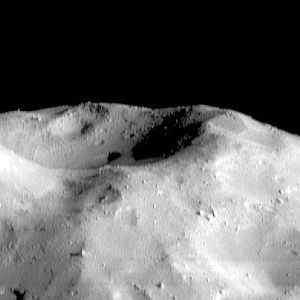  Craters and Boulders from an altitude of 23 miles; December 16, 2000, Source: NASA |

  Mosaic from an altitude of 31 miles August 20, 2000, Source: NASA |
  Last image before touchdown on February 12, 2001 Source: NASA/Planetary Society |


Deep Space 1: Braille - -  Stardust: Annefrank
Stardust: Annefrank
 - -  New Horizons: APL
New Horizons: APL
|
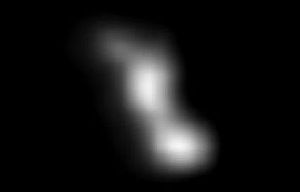  Asteroid 9969 Braille Source: Wikipedia |
  Asteroid 5535 Annefrank Source: Wikipedia |
  Asteroid 132524 APL December 16, 2000, Source: Wikipedia |

|
In 1999, 2002 and 2006, three probes on route to their designated targets passed two asteroids, but delivered only blurry images.
On July 29, 1999, on its way to comet Borrelly, NASA's Deep Space 1 passed asteroid 9969 Braille at a distance of 16 miles, but failed to get a focused picture. On November 2, 2002, on its way to comet Wild 2, NASA's Stardust probe passed asteroid 5535 Annefrank at a distance of 1,913 miles. On June 13, 2006, New Horizons, on its way to Pluto, took a picture of asteroid 132524 APL from a distance of approximately 634,000 miles (102,000 km). |


Hayabusa: Itokawa |
|
Next was the first sample return mission. Launched on May 9, 2003, the Japanese probe Hayabusa arrived at asteroid 25143 Itokawa on September 12, 2005 at a distance of 12 miles. The craft remained in a heliocentric orbit, closing in further on the asteroid. on November 19, 2005 Hayabusa landed on Itokawa, but the actual sample collection failed. On November 25, a second touchdown attempt was performed, succesfully collecting dust from the asteroid's surface. The probe returned sucessfully back to Earth on June 14, 2010 and delivered about 1,500 grains of rocky particles - the first sample from the Asteroid Belt. |
  Itokawa from five miles distance Source: JAXA/NASA |

  Artist's impression of Hayabusa collecting soil samples Source: Wikipedia |
  Itokowa's North Polar region November 1, 2005 Source: JAXA / ISAS / Planetary Society |
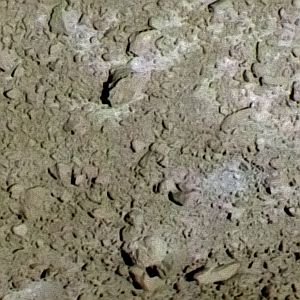  Closeup picture of Woomera Region during descent November 3, 2005 Source: JAXA / ISAS / Planetary Society |


Rosetta: Šteins, Lutetia |
|
On March 2, 2004, ESA launched the Rosetta spacecraft. Final destination of Rosetta was
comet Churyumov–Gerasimenko. Along the way, Rosetta's cameras were tested, when it passed asteroids 2867 Šteins (on September 5, 2008) and 21 Lutetia (on July 10, 2010). While Šteins with a diameter of just 3.1 miles is one of the smallest asteroids ever visited, Lutetia was at the time of the flyby the largest asteroid observed up close. |
  Artist view of ESA's Rosetta probe Source: ESA |
  Šteins from 500 miles distance Source: ESA |

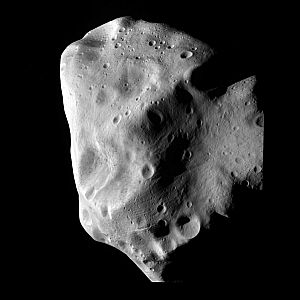  Lutetia from 1,965 miles distance Source: ESA |
  During the flyby on July 10, 2010, Rosetta shot an image of Lutetia with the planet Saturn in the back Source: ESA / Planetary Society |
  Colored mosaic image of Lutetia, July 10, 2010 Source: ESA / Planetary Society |


Chang'e 2: Toutatis |
|
China's probe Chang'e 2 was launched on October 1, 2010On 13 and became the country's
first lunar orbiter on October 6, 2010. On June 8, 2011, the probe left lunar orbit and arrived at the Earth–Sun L2 Lagrangian point on 25 August 25, 2011. In April 2012, Chang'e 2 departed L2 on an extended mission to near earth asteroid 4179 Toutatis. The probe successfully passed the asteroid in a distance of only 2 miles on December 13, 2012. |
 Artist's rendering of China's Chang'e 2 probe
Artist's rendering of China's Chang'e 2 probeSource: Gunter's Space Page |
  Asteroid Toutatis from a distance of 2 miles Source: Wikipedia |


Hayabusa 2: Ryugu |
|
Japan's Hayabusa 2 probe was launched
on December 3, 2014 and entered orbit around asteroid 162173 Ryugu on June 27, 2018. Hayabusa 2 performed complex operations involving three small landers, one impactor and two sample collection touch-downs. The first surface sampling was completed in February 22, 2019, when the probe obtained a substantial amount of regolith. After creating an artificial impact on the asteroid on April 5, 2019, a subsurface sample was taken from the impact crater on July 11, 2019. |
 Artist's view of JAXA's Hayabusa 2 probe
Artist's view of JAXA's Hayabusa 2 probeSource: Wikipedia |
  Ryugu from 12 miles distance Source: Wikipedia |

|
XXXXXMinerva Lander On September 21, 2018, Hayabusa 2's landing probe Minerva-II-1 landed on the asteroid and deployed two small devices that hop across the asteroid by moving a "torquer" in their interior. On September 22 at around 11:44 JST, Rover-1A transmitted the first picture from the surface of an asteroid.
A day later, the rover transmitted stunning closeup pictures from the surface.
|

 Artist's rendering of Minerva-II torquers Source: space.com
|
  First picture from the surface of an asteroid September 22, 2018; Source: JAXA |

  Closeup picture from Ryugu's surface, September 23, 2018 Source: JAXA |
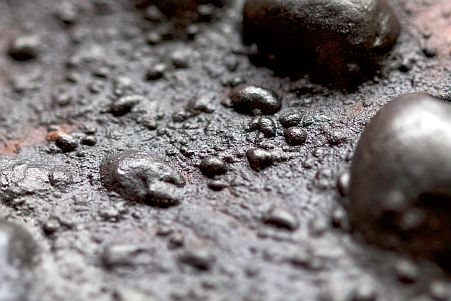  Closeup picture from Ryugu's surface, September 23, 2018 Source: JAXA |

|
XXXXXXXXXXXXMASCOT Lander Following the Minerva II rovers was the MASCOT (Mobile Asteroid Surface Scout) lander, developed by the German Aerospace Center and the French Space Agency. The battery powered rover, capable of tumbling once to reposition itself for further measurements, deployed on 3 October 2018 and operated for 16 hours. |

|
 |
|
Artist's rendering of MASCOT's deployment and touchdown Source: Planetary Society. |


 Ryugu's surface from the descending MASCOT probe Source: DLR / CNES / JAXA / Planetary Society |

 A few meters before touchdown Source: DLR / CNES / JAXA / Planetary Society |

|
XXXXXXXXXXXXXXXXXXXXXXSmall Carry-On Impactor On April 5, 2019, Hayabusa 2 deployed a small 5.5 lb copper project On impact, it excavated a crater of about 10 meters in diameter, exposing pristine material.
The picture to the right shows the spread of debris caught by Hayabusa2's deployable DCAM3 digital camera approximately 3 seconds after the SCI impact.
|
 |

  Artist's rendering of the SCI impact Source: Planetary Society |
  Impact area before... |
  ... and after the impact Source: sciencenews.org |

|
After the deployment of a reflective target marker on June 4, Hayabusa 2 touched down for a sub-surface sample collection on July 11, 2019. In December 2019, Hayabusa 2 will start its journey back to Earth. The probe is expected to land in Australia in December 2020.
The picture to the right shows an artist's rendering of the sample acquisition. |

|


OSIRIS-REx: Bennu |
|
NASA's OSIRIS-REx probe was launched on September 8, 2016 and entered orbit around asteroid
101955_Bennu on December 31, 2018. Until February 2020, the probe will survey and map the asteroid. A brief touchdown for sample acquisition is scheduled for July 2020. In March 2021, the probe will leave orbit and travel back to earth. The return capsule is scheduled to land in Utah on September 24, 2023. See complete timeline here.
|
  Artist's view of sample acquisition Source: Wikipedia |
  Mosaic image of Bennu from from a range of 15 miles December 2, 2018; Source: Wikipedia |


 Panoramic image from a from a height of about 3.6 kilometers, showing potential sample target area (left) March 29, 2919, Source: NASA / Planetary Society |

 Closeup from a distance of 2.8 km April 12, 2019; Source: NASA / Planetary Society |


Dawn: Vesta, Ceres |
|
On September 27, 2007, NASA launched the Dawn spacecraft, which on July 16, 2011 entered
an orbit around 4 Vesta, the largest asteroid visited to date. On September 5, 2012, Dawn left Vesta and on March 6, 2015, it arrived in orbit around 1 Ceres, becoming the first spacecraft in orbit of a dwarf planet and the first probe to orbit two objects other than the Earth and the Moon during the same mission. The last contact with the probe was on October 30, 2018. We dedicated an extra page to the pictures of Vesta and Ceres. |

  AsDawn mission patch Source: Wikipedia |
  Vesta from 3,200 miles; July 24, 2011 Source: Wikipedia |
  Ceres from 8,500 miles; October 21, 2015 Source: Wikipedia |


|
|
Click here to return to the Martian moons | Click here to move on to Vesta and Ceres |
|

|
Back to Solar System Page |
Back to Space Page |
Back to English Main Page |
 Back to Start Page |